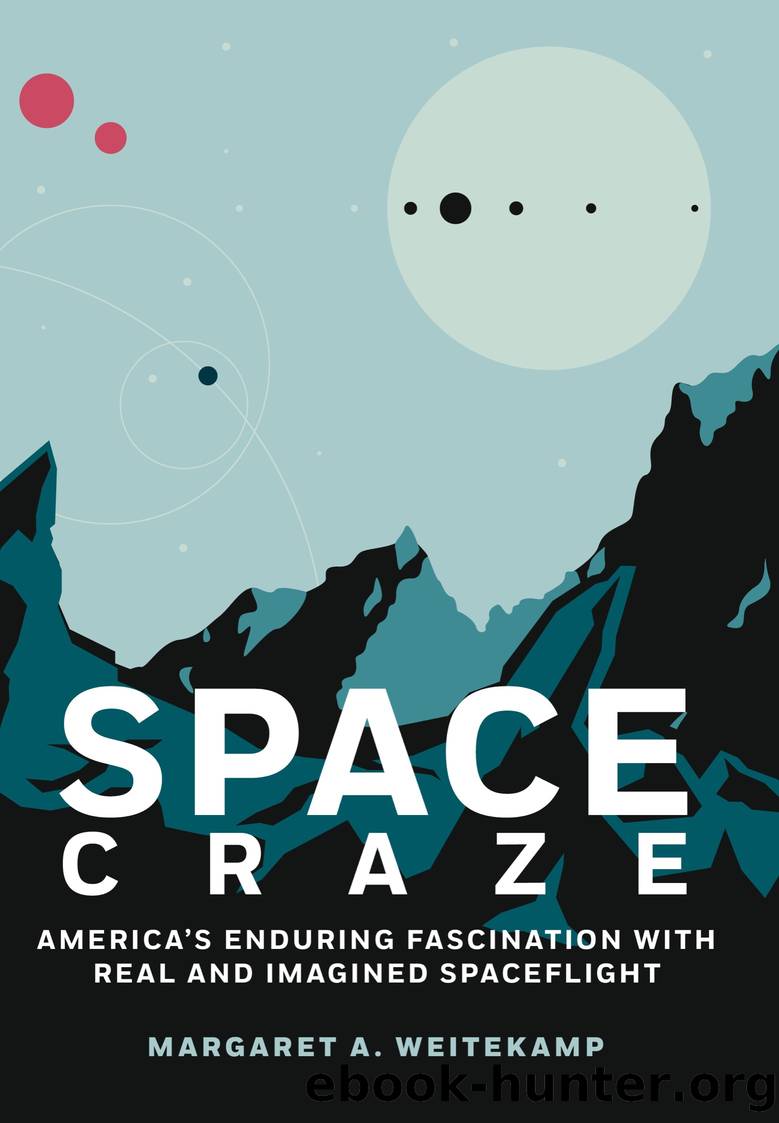Space Craze by Margaret A. Weitekamp

Author:Margaret A. Weitekamp [Weitekamp, Margaret A.]
Language: eng
Format: epub
Publisher: Smithsonian
Published: 2022-10-11T00:00:00+00:00
CAPRICORN ONE AND ALIEN
As the 1970s ended, popular depictions of spaceflight conveyed a pervasive sense of disillusionment. The eraâs cynicism permeates Capricorn One, a feature film released by Warner Brothers in June 1978. Writer and director Paul Hyams said he had the idea for the film in 1972 but could not get it funded until after Watergate made stories about deceit and corruption more relevant. The thriller depicts a space mission to Mars executed as a complete fraud. As mission control monitors a real launch, a NASA official extracts the unwitting crew, played by James Brolin, Sam Waterston, and O. J. Simpson. After the astronauts are whisked away to a secluded location and the conspiracy revealed to them, Dr. Kelloway (Hal Holbrook) appeals to the crew to perpetrate the deception: âNobody gives a crap about anything anymore. People close their garages and triple-lock their doors, hide under their beds. Theyâre even afraid to turn on their television sets for fear of what they might find out on the evening news. Thereâs nothing more to believe in. You want to blow this whole thing wide open? God knows what it might do to everybody.â As reporter Robert Caulfield (Elliott Gould) investigates various inconsistencies, the astronauts plot their escape, and the conspiracy begins to unravel. The film ends with a series of suspenseful chase scenes and the imminent revelation of the vast conspiracy underlying the deception.
Likewise, Ridley Scottâs Alien (1979) offers a dystopian vision of spaceflight. Part of what made the film so successfulâin addition to the pacing and effects that delivered shockingly memorable momentsâwas the way that it deliberately subverted the conventions of the space adventure genre. Working with Ronald Shusett to write the script, Dan OâBannon turned the genre disruption he had practiced in Dark Star from satiric to terrifying. Indeed, Alien includes several scenes that are so memorable as to be evoked in just a few words: the âface-huggerâ and the âchest-burster.â Critics had mixed opinions about the film, but it performed well with audiences during a movie season that Newsweek dubbed, âAmericaâs Scary Summer.â Alien broke the Star Wars record for opening, earning $8.5 million in select theaters before opening nationwide.
OâBannon and his cowriters deliberately wrote characters that were not clearly identified by race, ethnicity, gender, or other presuppositions. Nostromoâs workers are a racially integrated cast of men and women working together, not because it illustrated some futuristic ideal, as it had in Star Trek, but as a motley, workaday group thrown together by the requirements of their jobs. In this depiction, the adventure and heroics of space exploration transform into the tedium and drudgery of long-haul trucking, driven by profit for the benefit of an impersonal and uncaring Company. Both the casting and the set design reflect this. The actors are collectively almost a generation older than the fresh-faced, earnest young heroes depicted in kiddie space television shows in the 1950s. The workspace is lived-in. Nostromo is not powered by a faster-than-light engine that skips across
Download
This site does not store any files on its server. We only index and link to content provided by other sites. Please contact the content providers to delete copyright contents if any and email us, we'll remove relevant links or contents immediately.
| Aerodynamics | Aircraft Design & Construction |
| Astronautics & Space Flight | Avionics |
| Gas Dynamics | Propulsion Technology |
Whiskies Galore by Ian Buxton(41885)
Introduction to Aircraft Design (Cambridge Aerospace Series) by John P. Fielding(33064)
Small Unmanned Fixed-wing Aircraft Design by Andrew J. Keane Andras Sobester James P. Scanlan & András Sóbester & James P. Scanlan(32744)
Craft Beer for the Homebrewer by Michael Agnew(18145)
Turbulence by E. J. Noyes(7942)
The Complete Stick Figure Physics Tutorials by Allen Sarah(7312)
Kaplan MCAT General Chemistry Review by Kaplan(6868)
The Thirst by Nesbo Jo(6832)
Bad Blood by John Carreyrou(6558)
Modelling of Convective Heat and Mass Transfer in Rotating Flows by Igor V. Shevchuk(6392)
Learning SQL by Alan Beaulieu(6213)
Weapons of Math Destruction by Cathy O'Neil(6152)
Man-made Catastrophes and Risk Information Concealment by Dmitry Chernov & Didier Sornette(5926)
Digital Minimalism by Cal Newport;(5667)
Life 3.0: Being Human in the Age of Artificial Intelligence by Tegmark Max(5478)
iGen by Jean M. Twenge(5367)
Secrets of Antigravity Propulsion: Tesla, UFOs, and Classified Aerospace Technology by Ph.D. Paul A. Laviolette(5311)
Design of Trajectory Optimization Approach for Space Maneuver Vehicle Skip Entry Problems by Runqi Chai & Al Savvaris & Antonios Tsourdos & Senchun Chai(5012)
Pale Blue Dot by Carl Sagan(4917)
